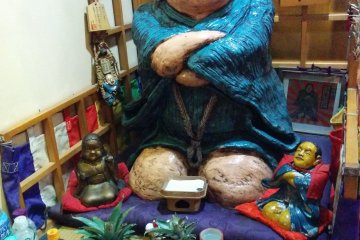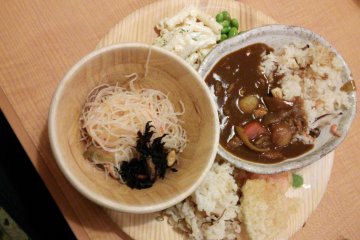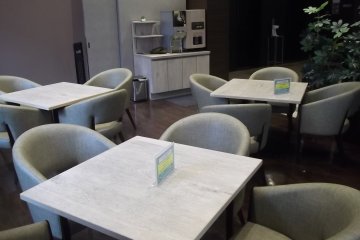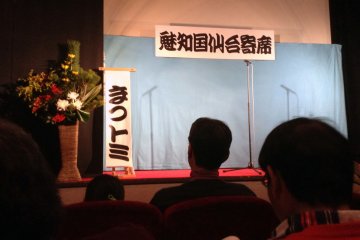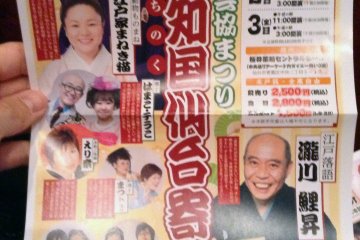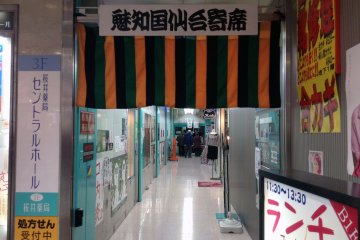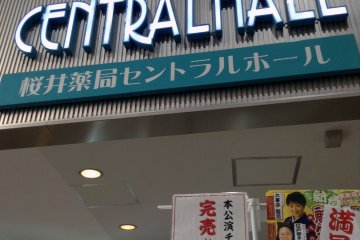The Japanese people may first appear strict, polite, and way too serious. I like to think the Japanese people know how to behave according to the situation. The workplace is for work, the bar is for drinking and relaxing, and the Michinoku Sendaiyose is for laughing! Michinoku is the old name for the Tohoku region, while Sendai is the region’s largest city and Miyagi Prefecture’s capital. Yose (寄席) can be translated as music hall, but basically everything from comedy, magic, storytelling, juggling, puppetry, circus acts, musical performances, and improv theater took place at such meeting places. These variety shows can be traced back to as early as the Heian era, but they really exploded in popularity in the Edo period. And now this traditional theater can be enjoyed by a modern audience in Sendai.
The show started off with some classic manzai duo comedy. Two women in dresses much more glamorous than their looks burst onto stage with giggles and a surge of energy. The tall, more feminine of the two played the straight role, setting up jokes for her partner which plays the fool. They really got the audience smiling and warmed up with clever wordplay, embarrassing mispronunciations, and fanciful ideas. More manzai was next with a husband/wife team that usually performs in Tokyo. The husband played the fool, as his wife constantly hit him over the head with her bag for doing such stupid things on stage. The highlight was when the husband pulled out a mini-plunger and made popping sounds with it on his shaven head to the tune of music. The whole crowd began to sing and clap along!! But manzai isn’t all you will experience at Sendaiyose.
Rakugo is also a mainstay and can be enjoyed every show. Rakugo is comedic storytelling by one person sitting on a mat and only using a folding fan and perhaps a small towel as props. Most often rakugo stories are repeated over and over for decades, so all are well known by regular fans. However, small changes, or on occasion entirely new stories are created to keep excitement. There was one storyteller that spoke in the regional dialect, so I barely understood a thing. However, I still appreciated the gestures and facial expressions. Another storyteller played the role of a grandfather talking with a young family member. Throughout the ten minute skit, the grandpa becomes drunker and drunker as his speech became questionable and his body prone to tipping and hiccups. The impersonation was incredibly skillful; I really thought this performer was intoxicated!
One or two musical/song performances are usually included in each month’s show. We enjoyed a performance by a shamisen (a three-string Japanese guitar) player from Aomori. She mixed a few modern melodies into her traditional songs. She even sang a little for us, as one of the regular attendees requested it after seeing her perform at Sendaiyose a year earlier. She was beyond professional—even playing each song with her eyes closed, by memory. I would have felt content just seeing her 20 minute performance for the whole admission price, but there was more!
Since it was my first performance, I can’t promise you’ll see any strange acts like these, but I am sure they come fairly often given the variety show theme. A female with a big smile, wrapped in a beautiful kimono, and coming from generations of entertainers took the stage. Her specialty: animal impersonations. It sounds ridiculous and was. We were all laughing out loud partly for the humor, and maybe more so because she was just so good! Making horse noises by hitting her face, cricket chirps with a special whistle technique, and who could forget the talking cat that wants more food?
I had a few concerns, but overall the show was amazing! Firstly, the seats were small. I am not that big of a guy and it was tight being smashed up against someone. I would recommend getting in early for an aisle seat. Also it was a bit warm in the theater, even on that winter day. Do bring something to drink. Lastly, the whole show is in Japanese. My Japanese is at an intermediate/low advanced level and I understood 70-80%. However, many of the jokes are physical. Also, acts like a musical performance can be enjoyed even without any understanding of Japanese. I was signaled out a few times by the performers because I am visibly not even close to being Japanese. Two confirmed an English word’s meaning with me mid-performance, while another said “Look! Our show is now international!” It was all in good fun though.
Here’s the details for the monthly shows:
On the first Saturday of every month, the Michinoku Sendaiyose company rents out the Sakurai Yakkyouku Central Hall movie theater to host their own variety show. Access via a 5 minute walk from Hirose-dori station, or a 15-20 minute walk from Sendai station. There are usually two performances each day and seating is first come, first serve. The 150 seat theater fills up quickly, so do arrive before show time. Tickets vary in price for each show, usually 2000-2800 yen with a slight discount if bought in advance, or for high school-aged and under attendees. Same day tickets can be bought at the front desk starting 30 minutes before the start of the show. Advance tickets can be bought in person at Mitsukoshi and Fuijisaki department stores, and the very same Sakurai Yakkyoku Building.



